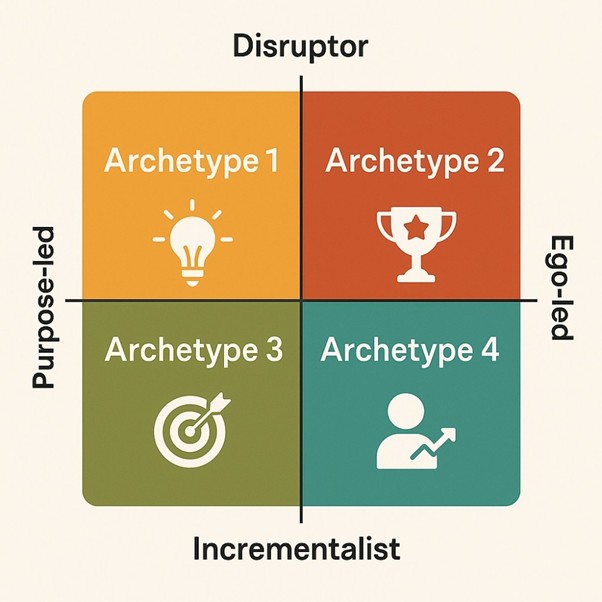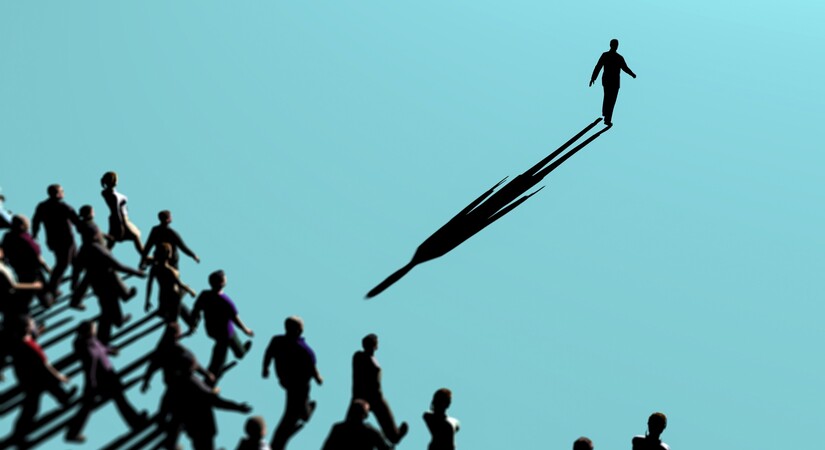Four archetypes of leadership in an age of disruption
Dr Andrew White, Founder & CEO of Transcend.Space
“Who are the leaders addressing the world’s biggest challenges? What decisions are they making? What solutions are they bringing?”
Four years ago, there was optimism about the future role of business leaders. With the rollout of COVID vaccines, the world was beginning to open up from lockdowns, and many organisations, having been forced to respond to the pressures that employees and stakeholders faced during the pandemic, had become more human-centric.
Meanwhile, a diverse workforce was considered something to aspire to, rather than a political choice. And ahead of COP26, there was a sense, encapsulated by various Net Zero pledges, that business could lead the world’s response to the climate emergency.
Since then? Harsh reality. Russia’s invasion of Ukraine in 2022 deepened geopolitical uncertainty and prompted global economic turmoil. Political instability has become normalised in the West. Social media, with its platforming of toxic influencers, is driving polarisation. Technological disruption has been rapid. Climate-driven crises, from the Valencia floods to California wildfires, continue to devastate.
Times of such intense disruption highlight how not all leaders are driven by the same forces, or produce the same kind of impact.
I have produced the following framework showing four archetypes of leadership — purpose-led disruptors, ego-led disruptors, purpose-led incrementalists and ego-led incrementalists — I am seeing in this age of disruption.

On one end, we see disruptors and on the other, we see incrementalists. Neither is the “right” approach. The important question is whether they lead with purpose, or ego? Here are some case studies, followed by some questions to consider at the bottom of this page.
Yvon Chouinard
In 2022, Chouinard handed Patagonia, the clothing company he founded, to a charitable trust with an instruction: all profits not reinvested in running the business would go to fighting climate change.
This couldn’t have been any further from the usual platitudes. It was the ultimate, and permanent, commitment. Where businesses have traditionally existed to maximise profits and/or shareholder value, Patagonia’s new structure put planetary value first. It was also a rejection of the traditional founder exit: instead of selling Patagonia to a private buyer or going public, Chouinard "opted out" of traditional capitalism entirely.
Clearly, this is not the approach every founder will take. But Chouinard made us ask: “How much is enough?” When we look at companies today, they become trapped by the power of success and unable to make radical change. Chouinard, instead of chasing more incremental gains, locked the company into a higher purpose.
Elon Musk
Musk has always been a business disruptor, but does his ego-led behaviour, particularly over the last year, have a negative impact on society?
First, it’s important to point out Musk’s leadership has many upsides. As I’ve written before, he is the antithesis of strategic laziness. He enjoys breaking things that have run out of road, and finding solutions. Frankly, it's an approach more business leaders need to adopt.
But Musk appears to thrive on conflict and controversy. During last year’s presidential election, for example, his false or misleading claims on X, his social media platform, amassed two billion views, according to a report. This came after he also shared misinformation during last summer’s UK riots. Since then, he has closely aligned with the Trump White House, leading the unofficial Department for Government Efficiency (Doge).
Is the public rejecting his leadership? Tesla reported a 20% drop in car sales for the first three months of the year, compared to the same period last year, while profits fell 70%. He subsequently announced a “significant” reduction in time spent on his Doge role to refocus on Tesla… arguably an act of humility.
Mary Barra
Musk was way ahead of established car manufacturers in implementing lower emission vehicles at scale. With Tesla, he kicked the entire Western car industry into action.
As chair and CEO of General Motors, Mary Barra has been incremental. She didn’t rush to compete directly with Tesla in the early EV boom, but has instead gradually shifted GM’s portfolio. “I want people to choose an EV because they love every aspect about it," she said last year. "And if it doesn’t fit their lifestyle, in that same showroom, we’ve got a great gas-powered vehicle that I think will meet their needs."
In 2021 — in that time of COVID optimism mentioned above — she pledged GM would stop making gas and diesel vehicles by 2035: which it remains committed to. At the heart of this, she said that year, is a cause: a vision of “a world with zero crashes, zero emissions, and zero congestion. The key to unlock that vision is electrification.”
Satya Nadella
“By the late ‘90s, Microsoft had achieved tremendous success. In fact, we became the company with the largest market cap,” Nadella said in 2023. “When that happened, people were walking around campus thinking they were God's gift to innovation. I like to frame this as us becoming know-it-alls.
“Later, I realised that this was not the case and that we needed a really important change from being know-it-alls to becoming learn-it-alls… In a school setting, you can really encourage kids to have a growth mindset by helping them learn from the mistakes they made. When they're not being know-it-alls, but learn-it-alls, then they are more successful. I felt like that also applies to CEOs and companies at large.”
As CEO of Microsoft, he considers this shift the most important cultural decision he has made at the company. And it reflects his measured leadership which has seen both innovation (such as the 2023 release of Copilot) and consolidation of the status quo (the continued development of Windows and Office/365 products).
At the same time, Nadella appears never to have lost sight of a broader mission beyond growth: from Microsoft's commitment to AI transparency and ethics at a time when other tech firms are accused of going too far, to its 2020 pledge to remove all carbon produced since its 1975 founding by 2050, which still stands today as other companies row back on their environmental promises.
Wael Sawan
A couple of months ago, I wrote about BP’s struggles to keep past promises to scale down oil and gas operations. This has also been the case at Shell, which last year scaled back its 2030 carbon reduction target and abandoned its 45% emissions cut target by 2035.
It was part of Sawan’s strategy to focus on higher-margin projects and increase payouts to shareholders, adding the 2035 target was "perilous" because "there is too much uncertainty at the moment in the energy transition trajectory".
On the one hand, oil and gas generate more returns for Shell. But it can also be argued Sawan slipped into the ego-led and incremental: choosing to extract more value from the status quo as opposed to attempting to transform it.
Food for thought
Purpose-led disruptor, ego-led disruptor, purpose-led incrementalist and ego-led incrementalist - how would you describe each of the leaders described above using these categories?
What percentage of leaders do you think are in each quadrant today - and what might this look like in five years’ time in 2030?
For each of these archetypes, what will enable a shift: for example, from ego-led disruptor to purpose-led disruptor?
In your opinion, what type of leadership do we need more of and what do we need less of?
To continue this discussion – contact the author, below, or reach out to Freshminds here. You can also learn more about developing leadership skills in our recent article, How Executive Coaching Can Reboot Businesses.
About the author
Dr Andrew White works globally with CEOs and executive leaders to understand how they can transcend the internal and external strategic challenges they face to ensure they deliver sustainable high performance.
He is the CEO of Transcend.Space, a company that supports CEOs and senior leaders with their transformational journeys through coaching and executive team retreats. Andrew has worked with CEOs and Government Ministers across Europe, North & South America, Africa, Asia, Australia & the Middle East.







